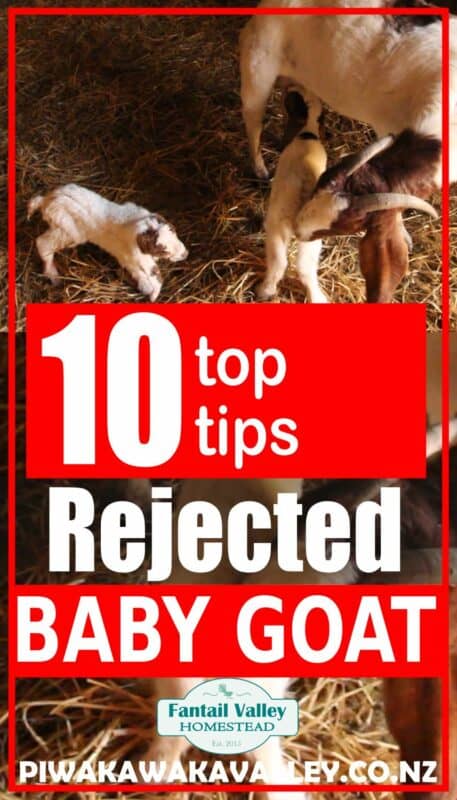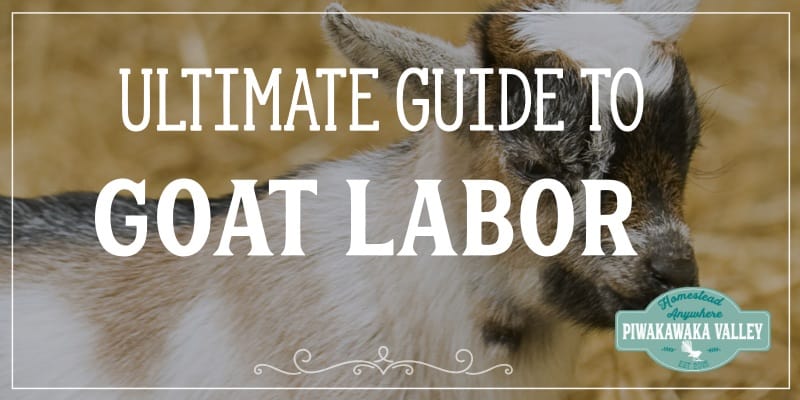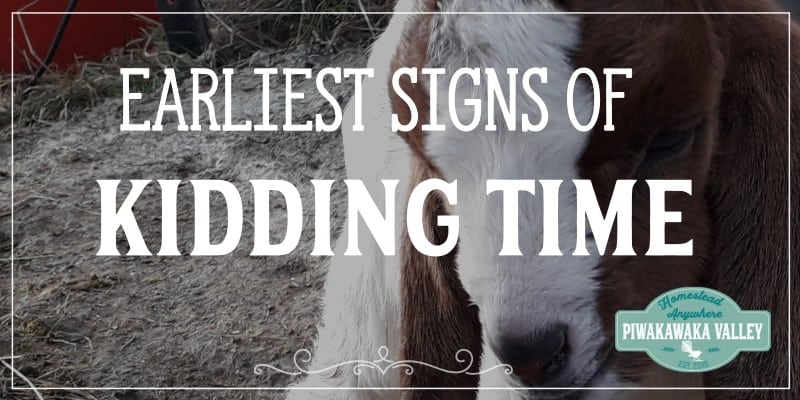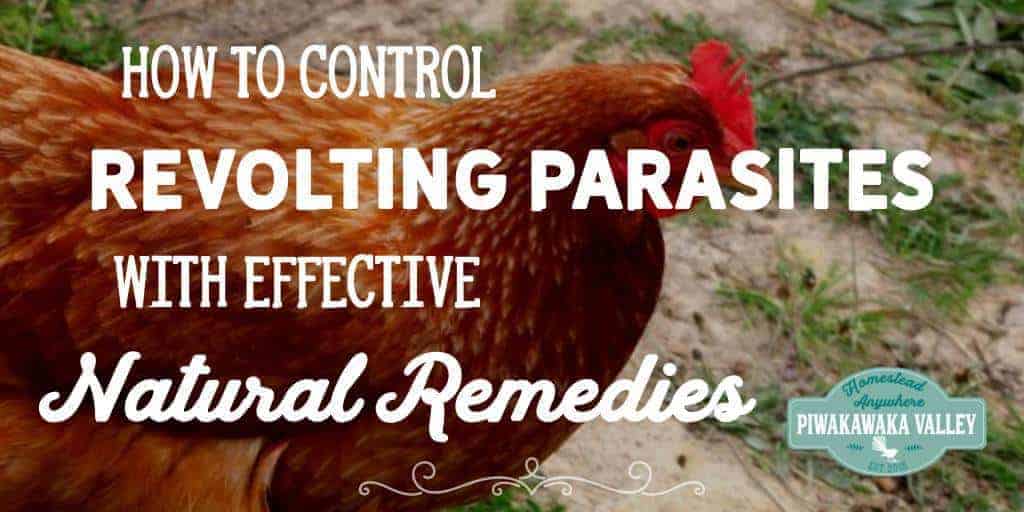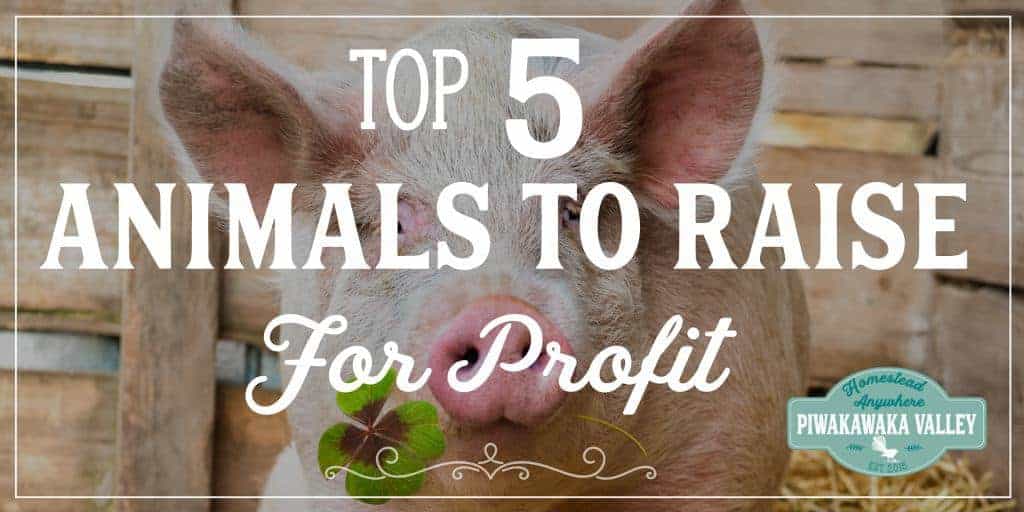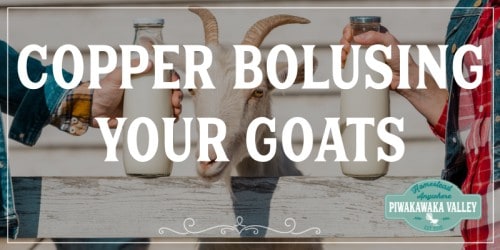Mother goat not recognizing baby goat
Has your doe had a baby goat that she has rejected? Maybe your mother goat is not recognizing her baby or is refusing to let the goat kid feed. Here are some reasons why your mother goat might have rejected or not recognize her babies, and what you can do to help the situation and encourage her to adopt the baby goats as her own.
Reasons why your mother goat is not recognizing her kids or is rejecting her baby
There are actually many reasons why your mother goat might be rejecting or not recognizing her baby or babies. Look at the list below and decide which might apply to your goat’s situation. You will have better luck pairing the mother goat back up with the rejected kid if you can work out the underlying cause/s.
Please read: This information is provided for educational purposes only and is not intended to treat, diagnose or prevent any disease. We encourage you to make your own health care decisions in partnership with a qualified health care professional.
This post contains affiliate links, this means at no extra cost to you, we make a commission from sales. Please read
our Disclosure Statement
1. First Fresher – a first time mother goat
A first time mother goat is referred to as a ‘first fresher’ and she often needs some help working out how to be a good mama.
Some breeding lines of goats are well known for their mothering abilities, but sadly many dairy herds are never given time to raise their own kids as the baby goats are pulled and bottle raised.
There is a correlation between the mothering ability between bottle raised and dam raised babies, but it appears to be a genetic difference rather than a circumstantial one.
So if your doe was bottle raised, but her mother had good mothering instincts, then your doe is more likely to have inherited her mothering traits, despite being bottle fed herself.
A first fresher might need some support and be kept alone with her babies for a time while she works out what she is meant to be doing.
2. A difficult or traumatic birth
Birth is a natural process, but sometimes it doesn’t go as easily as we would like. It is sad, but true, that an animal with a difficult birth out in the wild would be unlikely to live to pass the genes on to their offspring.
Domestic animals have the luxury of people helping them with their births if a baby goat is malpositioned or gets stuck. However, this can inadvertently can result in mothers that have narrower hips and larger heads and more difficult births.
A doe that experiences a traumatic birth will have lower levels of oxytocin, the bonding hormone. Oxytocin release is reduced if the levels of adrenaline get too high, and a lack of oxytocin can stop the mother goat from bonding with her baby goats.
3. A history of a difficult birth
If your goat’s last birth was traumatic, it can have lasting effects on her ability to recognize and bond with her next babies. This is especially true if her first baby was the difficult birth and she didn’t have to raise it – either it died, or was bottle raised.
Essentially now you have a first time mother, that has given birth before, but she did not have to learn also how to mother the kids, so she will still need to learn this skill.
Note – traumatic in this instance is not in relation to emotional trauma (which I am not going to argue one way or another if a goat experiences emotions) but trauma as in the medical sense of the word where there was damage incurred either by the doe or the kid(s) or both.
4. Poor mothering instinct
Some mama’s just don’t got what it takes to be a good mother and try as you might, she may never really develop the mothering instincts required to safely and effectively raise a baby goat.
It might be her genetics, or it might just be luck of the draw. It is up to you whether she is work keeping to breed next year or not. We usually do a 3 strikes and you are out sort of deal.
5. Intervention after the birth
The more you are involved in the birth and after the birth, the higher the chances are of the mother goat rejecting or refusing to recognize her newborn kid.
It is a fine line to walk to make sure all is OK without meddling too much and upsetting the balance.
6. A change of smells
One of the ways that well meaning labor helpers can upset the bonding process between mother and baby is to change the smell of the baby goat.
Rubbing a baby goat down to get it dry and remove the smell of the mother and replace it with the smell of washing powder from the towel.
Cuddling the baby to warm it up can add both your human smell and the smell of any perfume or deodorant that you are wearing.
If you do need to intervene in this way, keep some of the after birth and rub the baby back down gently with it to help cover it back up with mama smells.
Goats and sheep will usually sniff or lick at the baby goats behind while it feeds. Feeding a baby milk from another goat will result in a butt that smells like it belongs to the other mother.
This is a helpful fact if you are trying to graft an orphan kid, lamb or calf to a new mother, but it can work against you if you are using another milk as a top up for a weak kid. Sometimes this is unavoidable and must be done to save the kid, but if possible milk the mother goat and bottle feed her milk back to her own baby.
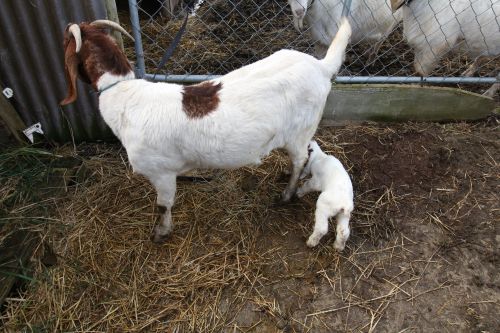

7. Udder issues
If your mother goat is rejecting her kids after a few days it is a really good idea to check her for signs of cuts, abrasions or mastitis on each teat. Mastitis is more common in dairy goat breeds that make a lot of milk and their little babies are not yet able to keep up with her supply.
We have a massive producer that I will milk out twice a day even when she has babies on her to avoid her getting mastitis because of her level of milk production.
If she is already showing signs of illness, you will need to strip her out a few times a day and give her medication supplied by your vet.
8. Baby goat’s mouth issues
Sometimes it isn’t the udder itself that is the issue but something wrong with the baby’s mouth. If your doe is reluctant to feed, check the baby’s mouth to make sure it hasn’t got any chipped, sharp, missing or malformed teeth that are hurting the doe’s udder when they feed.
9. Something wrong with the baby goat
Mother goats run on instinct, and they will often know if a baby has something wrong with it and will instinctively reject the weak, unwell or malformed baby. This is ultimately better for the progression of the species, but it is hard to see as a compassionate human.
We will usually try and save a rejected baby goat, sometimes there really is something wrong with them and they do not survive, other times they were just the weaker or slower of a multiple birth and given some care for a few days they learn to stand and feed and go on to be healthy individuals.
10. Stress
Stress messes with the best of us. A stressed brain cannot think straight will not be thinking about anything other than their own survival.
If a goat is panicked immediately after (or during) birthing, she will not look after the babies, she will focus on her own survival and may totally reject the babies.
High levels of cortisol and adrenaline is released during stressful situations and this blocks the production and receptors of the bonding hormone oxytocin. This happens in humans as well, stressed out mama’s will struggle to bond with her baby, no matter what the species.
What you can do if a mother goat doesn’t recognize her baby
If your mother goat doesn’t recognize her baby or is rejecting them, there are some things that you can do to help them bond.
1. Intervene as little as possible
There is a fine line between leaving nature to take its course and risk losing the baby, the mother or both, and intervening to save their lives but risk upsetting the bonding process.
The main point is to intervene as little as possible to have as many of the animals involved survive and to disrupt the birthing and bonding process as little as possible.
You can stack the odds in your favor by ensuring that the mother is somewhere warm and dry that she feels comfortable and not stressed.
2. Check the labor is actually finished
A laboring doe will often stop caring for the babies that are born while she focuses on pushing out the next one. If your doe isn’t licking and drying off the babies it is possible there is another one on the way.
Once a doe has passed her afterbirth (placenta) she is usually completed having babies.
3. Warm and dry the baby goat
A wet baby will chill and die quickly, especially if they are exposed to the wind. Use a dry towel or paper towels, dry the baby down thoroughly.
Place your (clean) finger in the baby goats mouth, if it is warm and they have a suck reflex then you are OK, if it is cold and there is no suck reflex, the baby will need a warm bath and a warm blow dry before attempting to feed it.
A cold baby cannot process milk, and you will cause it to die if you try and force feed a cold goat kid.
If the afterbirth is around still, dab it on the baby to cover up any foreign smells before returning the baby to its mother.
4. Bottle feed with her own milk
A mother goat relies on smell to tell her babies from other babies. They will usually smell the kid goat as they feed, so if the baby has had milk from another goat, molasses water or milk replacement then their bottoms will smell different than she expects.
This means that if you can, feed the baby goats her own milk. Get someone to hold her, distract her with some treats to eat, and try to latch on the babies. If they won’t latch and you need to bottle or tube feed, try to milk out some of her milk to feed back to her kids if possible.
The importance of colostrum
Colostrum is the very first milk that your doe will make. It is thick, yellow and full of nutrients that the baby needs. Goats that have not had colostrum in the first 24 hours will likely die, it is that important.
If you cannot possibly give the baby goat any from its mother, you can use either frozen colostrum or a colostrum replacer.
Colostrum contains antibodies, probiotics and is very high in nutrients so it doesn’t matter if the baby goats aren’t great at suckling for their first few feeds.
5. Pen them up together
If the baby goats are up and about and trying to feed and the mother goat still isn’t interested in them, now is the time to pen them up together.
You need the pen to be warm and dry, large enough for the mother to walk around, and secure so she can’t escape.
It is ideal if you have a way to restrain her while you allow the babies to feed, a milking stand or collar and lead tied to something is ideal.
Add plenty of hay for the nanny goat to eat, fresh water for her to drink, and plenty of bedding for the babies.
6. Help the baby goat feed several times a day
Every 2-3 hours for the first 24 hours, go and hold the mother goat and allow the babies time to be able to nurse.
To start with you might need to help weak or feeble (or plain daft) babies to stand and or latch on until they get the hang of it.
The release of oxytocin that the mother will experience everytime she lets down milk will help build the bond between them.
7. Keep your doe well nourished
Making milk is demanding on a new mother. Supply her with plenty of hay for the long fibers, and a balanced goat feed several times a day.
Be sure that she has access to a salt or mineral lick and plenty of water.
8. Keep the baby goats safe
If your doe is being aggressive to her kids, you might need to pen the babies up within her pen so she can see and smell them but not hurt them. A large dog crate is perfect for this.
Some does will simply not warm to her babies, and you are better off taking them somewhere safe away from her and bottle raising them.
What to do if you find an abandoned kid
It is normal for a mother goat to leave her baby somewhere safe and to go off and find herself food and water. If you find a warm and dry, well fed baby goat out in the pasture or forest, chances are its mother is not far away.
The best thing you can do is wait and see if she comes back.
If you find a cold, wet or starving baby goat, it might have been abandoned.
The priority is to get it warm – a warm bath is a good option – and dry. Once warm and dry you can look at feeding the baby. If it has no suck reflex it will need to be tube fed.
If it has a suck reflex, try offering a little warmed colostrum or colostrum replacer. If you don’t have either of these on hand some milk replacer will do until you can get some goat colostrum.
When to decide to bottle feed a kid
If after 5-7 days a mother goat is still rejecting her baby, it might be time to call it quits and bottle feed the baby goat instead.
If your doe is being violent with the baby kid, you may need to do this sooner than this or the baby may not survive. Bottle feeding a baby goat is quite a commitment as the kids will need fed every 2-3 hours to start with, slowly weaning down to 4 times a day.
Replacement goat milk can be expensive, and baby goats won’t always do as well on it as they would have being raised on fresh goat’s milk. If you have the ability to milk one of your does and then use this for your bottle baby it can reduce the price and improve the outcomes in the orphan goats, giving you a more healthy goat kid.
Cow’s milk is not suitable for baby goats, but if you have a lactating ewe that will let you milk her, you can feed the baby goats sheep’s milk.
If you have does that are about to give birth it is a good idea to have some milk replacer and some powdered colostrum on hand as well as a bottle suitable to feeding baby goats. We buy these nipples and use them on a soda bottle as they are a universal size.
